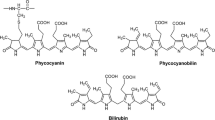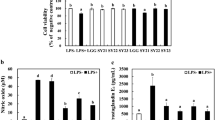Abstract
In the present study, we investigated the effects of Alpinia katsumadai HAYATA (Zingiberaceae) seed ethanolic extract (AKEE) and its three components on the production of inflammatory mediators and some potential underlying mechanisms in lipopolysaccharide (LPS)-induced inflammation RAW264.7 cells. The whole formula, AKEE, and three major component compounds were then evaluated for their effects on inflammation-related parameters using LPS-induced RAW264.7 cells. Production of namely nitric oxide (NO) and cytokine levels were measured by the Griess reagent and ELISA, respectively. To investigate the underlying mechanisms of anti-inflammatory activities of AKEE, protein expression of nitric oxide synthase (inducible nitric oxide synthase, iNOS), heme oxygenase-1 (HO-1), and nuclear factor-kappa B (NF-κB) were evaluated by western blot analysis. AKEE and the major group of compounds in AKEE (alpinetin, cardamonin, and pinocembrin) complement exert anti-inflammatory effects for NO and PGE2 production. In addition, AKEE treatment significantly inhibited the LPS-induced production of interleukin-6 and tumor necrosis factor (TNF)-α, as well as the expression of iNOS. AKEE also induced HO-1 expression in RAW264.7 cells and inhibited the nuclear translocation of NF-κB by preventing degradation of the inhibitor kappa B-alpha. We also demonstrated that the effects of AKEE on TNF-α production were partially reversed by the HO-1 inhibitor tin protoporphyrin. These results indicate that AKEE and its major component may have anti-inflammatory activity via induction of HO-1 expression was partly responsible for the anti-inflammatory effects.







Similar content being viewed by others
REFERENCES
Baumann, H., and J. Gauldie. 1994. The acute phase response. Immunology Today 15: 74–80.
Lawrence, T., D.A. Willoughby, and D.W. Gilroy. 2002. Anti-inflammatory lipid mediators and insights into the resolution of inflammation. Nature Reviews Immunology 2: 787–795.
Ohshima, H., and H. Bartsch. 1994. Chronic infections and inflammatory processes as cancer risk factors: possible role of nitric oxide in carcinogenesis. Mutation Research 305: 253–264.
Verstak, B., P. Hertzog, and A. Mansell. 2007. Toll-like receptor signaling and the clinical benefits that lie within. Inflammation Research 56: 1–10.
Ulevitch, R.J., and P.S. Tobias. 1995. Receptor-dependent mechanisms of cell stimulation by bacterial endotoxin. Annual Review of Immunology 13: 437–457.
Chen, Z., J. Hagler, V.J. Palombella, F. Melandri, D. Scherer, D. Ballard, and T. Maniatis. 1995. Signal-induced site-specific phosphorylation targets I kappa B alpha to the ubiquitin–proteasome pathway. Genes & Development 9: 1586–1597.
Karin, M., and Y. Ben-Neriah. 2000. The control of NF-κB activity. Annual Review of Immunology 18: 621–663.
Ryter, W., L.E. Otterbein, D. Morse, and A.M.K. Choi. 2002. Heme oxygenase/carbon monoxide signaling pathways: regulation and functional significance. Molecular and Cellular Biochemistry 234–235: 249–263.
Chung, H.T., H.O. Pae, and Y.N. Cha. 2008. Role of heme oxygenase-1 in vascular disease. Current Pharmaceutical Design 14: 422–428.
Abraham, N.G., and A. Kappas. 2008. Pharmacological and clinical aspects heme oxygenase. Pharmcological Reviews 60: 79–127.
Otterbein, L.E., L.L. Mantell, and A.M. Choi. 1999. Carbon monoxide provides protection against hyperoxic lung injury. American Journal of Physiology 276(4 Pt 1): L688–L694.
Ryter, S.W., J. Alam, and A.M. Choi. 2006. Heme oxygenase-1/carbon monoxide: from basic science to therapeutic applications. Physiological Reviews 86: 583–650.
Wink, D.A., and J.B. Mitchell. 1998. Chemical biology of nitric oxide: Insights into regulatory, cytotoxic, and cytoprotective mechanisms of nitric oxide. Free Radical Biology & Medicine 25: 434–456.
Lee, S.E., H.T. Shin, H.J. Hwang, and J.H. Kim. 2003. Antioxidant activity of extracts from Alpinia katsumadai seed. Phytotherapy Research 17: 1041–1047.
Ahmad, S., D.A. Israf, N.H. Lajis, K. Shaari, H. Mohamed, A.A. Wahab, K.T. Ariffin, W.Y. Hoo, N.A. Aziz, A.A. Kadir, M.R. Sulaiman, and M.N. Somchit. 2006. Cardamonin, inhibits pro-inflammatory mediators in activated RAW 264.7 cells and whole blood. European Journal of Pharmacology 538: 188–194.
Huang, W.Z., X.J. Dai, Y.Q. Liu, C.F. Zhang, M. Zhang, and Z.T. Wang. 2006. Studies on antibacterial activity of flavonoids and diarylheptanoids from Alpinia katsumadai. Journal of Plant Resources and Environment 15: 37–40.
Lee, M.Y., N.H. Lee, C.S. Seo, J.A. Lee, D. Jung, J.H. Kim, and H.K. Shin. 2010. Alpinia katsumadai seed extract attenuate oxidative stress and asthmatic activity in a mouse model of allergic asthma. Food and Chemical Toxicology 48: 1746–1752.
Yang, J., Y. Dai, Y.F. Xia, W.Z. Huang, and Z.T. Wang. 2009. Alpinia katsumadai Hayata prevents mouse sepsis induced by cecal ligation and puncture through promoting bacterial clearance and downregulating systemic inflammation. Phytotherapy Research 23: 267–273.
Tang, J., N. Li, H. Dai, and K. Wang. 2010. Chemical constituents from seeds of Alpinia katsumadai, inhibition on NF-kappaB activation and anti-tumor effect. Zhongguo Zhong Yao Za Zhi 35: 1710–1714.
Lee, S.H., E. Soyoola, P. Chanmugam, S. Hart, W. Sun, H. Zhong, S. Liou, D. Simmons, and D. Hwang. 1992. Selective expression of mitogen-inducible cyclooxgenase in macrophages stimulated with lipopolysaccharide. Journal of Biological Chemistry 267: 25934–25938.
Diehl, S., and M. Rincon. 2002. The two faces of IL-6 on Th1/Th2 differentiation. Molecular Immunology 39: 531–536.
Rice, T.W., and G.R. Bernard. 2005. Therapeutic intervention and targets for sepsis. Annual Review of Medicine 56: 225–248.
Kim, S.J., H.J. Jeong, P.D. Moon, K.M. Lee, H.B. Lee, H.J. Jung, H.K. Rhee, D.C. Yang, S.H. Hong, and H.M. Kim. 2005. Anti-inflammatory activity of gumiganghwaltang through the inhibition of nuclear factor-kappa B activation in peritoneal macrophages. Biological & Pharmaceutical Bulletin 28: 233–237.
Kapturczak, M.H., C. Wasserfall, T. Brusko, M. Campbell-Thompson, T.M. Ellis, M.A. Atkinson, and A. Agarwal. 2004. Heme oxygenase-1 modulates early inflammatory responses: evidence from the heme oxygenase-1-deficient mouse. American Journal of Pathology 165: 1045–1053.
Mannaioni, P.F., A. Vannacci, and E. Masini. 2006. Carbon monoxide: the bad and the good side of the coin, from neuronal death to anti-inflammatory activity. Inflammation Research 55: 261–273.
Otterbein, L.E., M.P. Soares, K. Yamashita, and F.H. Bach. 2003. Heme oxygenase-1: unleashing the protective properties of heme. Trends in Immunology 24: 449–455.
Oh, G.S., H.O. Pae, B.S. Lee, B.N. Kim, J.M. Kim, H.R. Kim, S.B. Jeon, W.K. Jeon, H.J. Chae, and H.T. Chung. 2006. Hydrogen sulfide inhibits nitric oxide production and nuclear factor-kappaB via heme oxygenase-1 expression in RAW264.7 macrophages stimulated with lipopolysaccharide. Free Radical Biology & Medicine 41: 106–119.
Roshak, A., J.R. Jackson, M. Chabot-Fletcher, and L.A. Marshall. 1997. Inhibition of NF kappaB-mediated interleukin-1beta-stimulated prostaglandin E2 formation by the marine natural product hymenialdisine. Journal of Pharmacology and Experimental Therapeutics 283: 955–961.
Yoshimura, A. 2006. Signal transduction of inflammatory cytokines and tumor development. Cancer Science 97: 439–447.
Rafiee, P., C.P. Johnson, M.S. Li, H. Ogawa, J. Heidemann, P.J. Fisher, T.H. Lamirand, M.F. Otterson, K.T. Wilson, and D.G. Binion. 2002. Cyclosporine A enhances leukocyte binding by human intestinal microvascular endothelial cells through inhibition of p38 MAPK and iNOS. Paradoxical proinflammatory effect on the microvascular endothelium. Journal of Biological Chemistry 277: 35605–35615.
Yin, H., F. Zhang, M. Yu, H. Cheng, J. Lin, Y. Gao, B. Han, and L. Zhu. 2005. Beta-endorphin ameliorates synovial cell hyperfunction in the collagen-induced arthritis rat model by specific downregulation of NF-kappa B activity. Neuroendocrinology 81: 10–18.
Ghosh, S., and M.S. Hayden. 2008. New regulators of NF-κB in inflammation. Nature Reviews Immunology 8: 837–848.
ACKNOWLEDGMENTS
This research was supported by a grant “Evidence-based Medicine for herbal formulae” from Korea Institute of Oriental Medicine (KIOM).
Competing Interests
The authors declare that they have no competing interests.
Author information
Authors and Affiliations
Corresponding author
Additional information
Mee-Young Lee and Chang-Seob Seo equally contributed to this work.
Rights and permissions
About this article
Cite this article
Lee, MY., Seo, CS., Lee, JA. et al. Alpinia katsumadai HAYATA Seed Extract Inhibit LPS-Induced Inflammation by Induction of Heme Oxygenase-1 in RAW264.7 Cells. Inflammation 35, 746–757 (2012). https://doi.org/10.1007/s10753-011-9370-0
Published:
Issue Date:
DOI: https://doi.org/10.1007/s10753-011-9370-0




